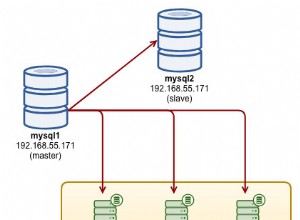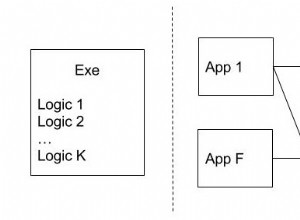Se avevi un numero noto di valori per entrambi order e item , quindi potresti codificare la query in:
select id,
max(case when `order` = 1 then data end) order1,
max(case when `order` = 2 then data end) order2,
max(case when `order` = 3 then data end) order3,
max(case when item = 1 then price end) item1,
max(case when item = 2 then price end) item2,
max(case when item = 3 then price end) item3,
max(case when item = 4 then price end) item4
from tableA
group by id;
Vedi Demo . Ma parte del problema che avrai è perché stai cercando di trasformare più colonne di dati. Il mio suggerimento per ottenere il risultato finale sarebbe prima di annullare il pivot dei dati. MySQL non ha una funzione unpivot ma puoi usare UNION ALL per convertire più coppie di colonne in righe. Il codice da annullare sarà simile al seguente:
select id, concat('order', `order`) col, data value
from tableA
union all
select id, concat('item', item) col, price value
from tableA;
Vedi Demo . Il risultato sarà:
| ID | COL | VALUE |
-----------------------
| 1 | order1 | P |
| 1 | order1 | P |
| 1 | order1 | P |
| 1 | item1 | 50 |
| 1 | item2 | 60 |
| 1 | item3 | 70 |
Come puoi vedere questo ha preso le colonne multiple di order /data e item /price e convertilo in più righe. Una volta completato, puoi riconvertire i valori in colonne utilizzando una funzione di aggregazione con CASE:
select id,
max(case when col = 'order1' then value end) order1,
max(case when col = 'order2' then value end) order2,
max(case when col = 'order3' then value end) order3,
max(case when col = 'item1' then value end) item1,
max(case when col = 'item2' then value end) item2,
max(case when col = 'item3' then value end) item3
from
(
select id, concat('order', `order`) col, data value
from tableA
union all
select id, concat('item', item) col, price value
from tableA
) d
group by id;
Vedi Demo . Infine, devi convertire il codice sopra in una query di istruzione preparata dinamica:
SET @sql = NULL;
SELECT
GROUP_CONCAT(DISTINCT
CONCAT(
'max(case when col = ''',
col,
''' then value end) as `',
col, '`')
) INTO @sql
FROM
(
select concat('order', `order`) col
from tableA
union all
select concat('item', `item`) col
from tableA
)d;
SET @sql = CONCAT('SELECT id, ', @sql, '
from
(
select id, concat(''order'', `order`) col, data value
from tableA
union all
select id, concat(''item'', item) col, price value
from tableA
) d
group by id');
PREPARE stmt FROM @sql;
EXECUTE stmt;
DEALLOCATE PREPARE stmt;
Vedi SQL Fiddle con demo . Questo dà un risultato:
| ID | ORDER1 | ORDER2 | ORDER3 | ITEM1 | ITEM2 | ITEM3 | ITEM4 |
-------------------------------------------------------------------
| 1 | P | Q | (null) | 50 | 60 | 70 | (null) |
| 2 | P | (null) | S | 50 | 60 | (null) | 80 |




